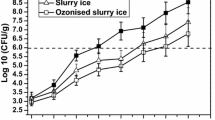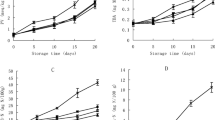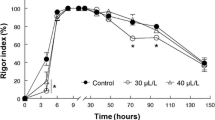Abstract
The effects of washing whole scad (Trachurus trachurus) with fresh water and seawater were evaluated. Fish evaluations for 12 days of storage in ice included sensory (EU and the QIM scheme), physical (Torrymeter and Freshmeter) and microbiological changes [counts of total bacterial numbers, specific spoilage organisms (SSO) and Pseudomonas]. The main conclusions are that both kinds of wash influenced physical and microbiological evaluations (mainly on Freshmeter values and counts of SSO). Washes seemed to interfere with properties of the fish skin cells that influenced the instrumental readings. By sensory means, the effects were not detected, resulting in similar shelf-lives, although some slight differences could be observed in mucus brightness in the first 2 days storage in ice. No significant differences were found between washing with tap water and treated seawater, but slightly lower values were obtained initially with seawater, in the first 24–48 h, with the Torrymeter and the Freshmeter.







Similar content being viewed by others
References
Smith JGM (1989) Handling and processing scad. Torry Advisory Note no. 93, Torry Research Station, Aberdeen
FAO—Food and Agriculture Organization of the United Nations (2002) Available from:http://www.fao.org/globfish/doc
Howgate PF (1982) Quality assessment and quality control. In: Aitken A et al. (eds) Fish handling and processing, 2nd edn. Her Majesty's Stationary, Edinburgh, pp 177–86
Howgate P, Johnston A, Whittle KJ (1992) Multilingual guide to EC freshness grades for fishery products. Torry Research Station, Food Safety Directorate, Ministry of Agriculture, Fisheries and Food, Aberdeen, Scotland
Martinsdóttir E (1997) Sensory evaluation in research of fish freshness. In: Olafsdóttir G, Luten J, Dalgaard P, Careche M, Verrez-Bagnis V, Martinsdóttir E, Heia K (eds) Methods to determine the freshness of fish in research and industry. International Institute of Refrigeration, Paris, pp 306–312
Nielsen J (1997) Sensory analysis of fish. In: Olafsdóttir G, Luten J, Dalgaard P, Careche M, Verrez-Bagnis V, Martinsdóttir E, Heia K (eds) Methods to determinate the freshness of fish in research and industry. International Institute of Refrigeration, Paris, pp 279–286
Bremner HA, Sakaguchi M (2000) J Aquat Food Prod Tech 9:5–25
Pedrosa-Menabrito A, Regenstein JM (1990) J Food Quality 13:209–23
EC Regulation (1996) Council Regulation (EC) No. 2406/96 of 26 November 1996 laying down common marketing standards for certain fishery products. Official Journal of the European Union L 334, 23/12/1996, 1–15
Bremner AH (1985) Fish Proc Bull 7:59–70
Larsen P, Heldbo J, Jespersen CM, Nielsen J (1992) Development of a method for quality assessment of fish for human consumption based on sensory evaluation. In: Huss HH, Jakobsen M, Liston J (eds) Quality assurance in the fish industry. Elsevier, Amsterdam, pp 351–358
Ólafsdóttir G, Martinsdóttir E, Verrez-Bagnis V, Dalgaard P, Luten JB, Careche M, Heia K (1997) The need for methods to evaluate fish freshness. In: Olafsdóttir G, Luten J, Dalgaard P, Careche M, Verrez-Bagnis V, Martinsdóttir E, Heia K (eds) Methods to determinate the freshness of fish in research and industry. International Institute of Refrigeration, Paris, pp 17–29
Pivarnik LF, Kazantzis D, Karaholtsidis PA, Constantinides S, Jhaveri SN, Rand AG (1990) J Food Sci 55:79–82
Vaz-Pires P, Araújo I, Kirby RM (1995) Int J Food Sci Tech 30:799–805
Heia K, Sigernes F, Nilsen H, Oehlenshläger J, Schubring K, Borderías J, Nilsson K, Jørgensen B, Nesvabda P (1997) Evaluation of fish freshness by physical measurement techniques. In: Olafsdóttir G, Lutten J, Dalgaard P, Careche M, Verrez-Bagnis V, Martinsdóttir E, Heia K (eds) Methods to determine the freshness of fish in research and industry. International Institute of Refrigeration, Paris, pp 347–354
Lees A, Smith GL (1980) Assessment of the freshness of fillets by the GR Torrymeter. In: Connell JJ (ed) Advances in fish science and technology. Fishing News Books, Oxford, pp 400–403
Huss HH (1998) Quality and quality changes in fresh fish. FAO Fisheries Technical Paper 348
Jorgensen BR, Gibson DM, Huss HH (1988) Int J Food Microbiol 6:295–307
Gram L, Trolle G, Huss HH (1987) Int J Food Microbiol 4:65–72
Gram L, Huss HH (1996) Int J Food Microbiol 3:121–37
Huidobro A, Pastor A, López-Caballero ME, Tejada M (2001) Eur Food Res Technol 212:408–12
Ashie INA, Smith JP, Simpson BK (1996) Crit Rev Food Sci 36: 87–121
Beuchat LR (1992) Dairy Food Environ Sanit 12:6–9
Clesceri LS, Greenberg AE, Eaton AD (1998) Standard methods for the examination of water and wastewater, 20th edn. American Public Health Association, Washington
Andrade A, Nunes L, Batista I (1997) Freshness quality grading of small pelagic species by sensory analysis. In: Olafsdóttir G, Lutten J, Dalgaard P, Careche M, Verrez-Bagnis V, Martinsdóttir E, Heia K (eds) Methods to determine the freshness of fish in research and industry. International Institute of Refrigeration, Paris, pp 333–338
Barbosa A, Bremner HA, Vaz-Pires P (2002) The meaning of shelf-life. In: Bremner HA (ed) Safety and quality issues in fish processing. Woodhead, Cambridge, pp 173–190
Barbosa A, Vaz-Pires P (in press) Food Control
Vaz-Pires P, Capell C, Kirby R (1994) Int J Food Sci Tech 29 (4):405–413
Vaz-Pires P (1995) Efficacy of heat treatments for reducing microbial activity during refrigerated storage of fresh fish. PhD thesis. Escola Superior de Biotecnologia, Universidade Católica Portuguesa, Porto, Portugal
Author information
Authors and Affiliations
Corresponding author
Rights and permissions
About this article
Cite this article
Inácio, P., Bernardo, F. & Vaz-Pires, P. Effect of washing with tap and treated seawater on the quality of whole scad (Trachurus trachurus). Eur Food Res Technol 217, 406–411 (2003). https://doi.org/10.1007/s00217-003-0771-7
Received:
Revised:
Published:
Issue Date:
DOI: https://doi.org/10.1007/s00217-003-0771-7




